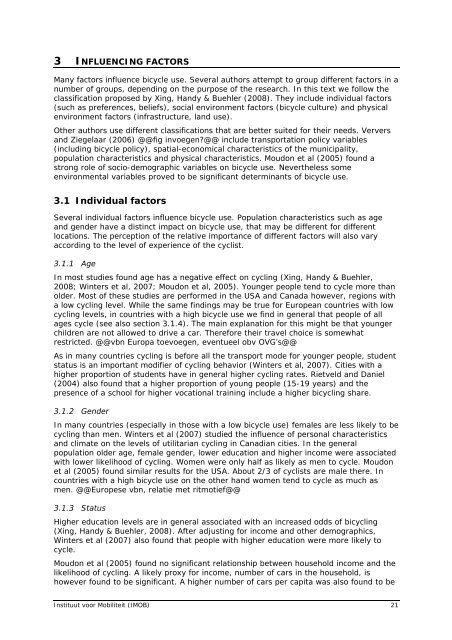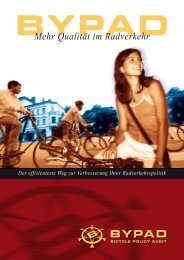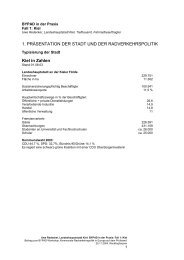Annex I: Literature search bicycle use and influencing ... - ByPAD
Annex I: Literature search bicycle use and influencing ... - ByPAD
Annex I: Literature search bicycle use and influencing ... - ByPAD
Create successful ePaper yourself
Turn your PDF publications into a flip-book with our unique Google optimized e-Paper software.
3 INFLUENCING FACTORS<br />
Many factors influence <strong>bicycle</strong> <strong>use</strong>. Several authors attempt to group different factors in a<br />
number of groups, depending on the purpose of the re<strong>search</strong>. In this text we follow the<br />
classification proposed by Xing, H<strong>and</strong>y & Buehler (2008). They include individual factors<br />
(such as preferences, beliefs), social environment factors (<strong>bicycle</strong> culture) <strong>and</strong> physical<br />
environment factors (infrastructure, l<strong>and</strong> <strong>use</strong>).<br />
Other authors <strong>use</strong> different classifications that are better suited for their needs. Ververs<br />
<strong>and</strong> Ziegelaar (2006) @@fig invoegen?@@ include transportation policy variables<br />
(including <strong>bicycle</strong> policy), spatial-economical characteristics of the municipality,<br />
population characteristics <strong>and</strong> physical characteristics. Moudon et al (2005) found a<br />
strong role of socio-demographic variables on <strong>bicycle</strong> <strong>use</strong>. Nevertheless some<br />
environmental variables proved to be significant determinants of <strong>bicycle</strong> <strong>use</strong>.<br />
3.1 Individual factors<br />
Several individual factors influence <strong>bicycle</strong> <strong>use</strong>. Population characteristics such as age<br />
<strong>and</strong> gender have a distinct impact on <strong>bicycle</strong> <strong>use</strong>, that may be different for different<br />
locations. The perception of the relative importance of different factors will also vary<br />
according to the level of experience of the cyclist.<br />
3.1.1 Age<br />
In most studies found age has a negative effect on cycling (Xing, H<strong>and</strong>y & Buehler,<br />
2008; Winters et al, 2007; Moudon et al, 2005). Younger people tend to cycle more than<br />
older. Most of these studies are performed in the USA <strong>and</strong> Canada however, regions with<br />
a low cycling level. While the same findings may be true for European countries with low<br />
cycling levels, in countries with a high <strong>bicycle</strong> <strong>use</strong> we find in general that people of all<br />
ages cycle (see also section 3.1.4). The main explanation for this might be that younger<br />
children are not allowed to drive a car. Therefore their travel choice is somewhat<br />
restricted. @@vbn Europa toevoegen, eventueel obv OVG’s@@<br />
As in many countries cycling is before all the transport mode for younger people, student<br />
status is an important modifier of cycling behavior (Winters et al, 2007). Cities with a<br />
higher proportion of students have in general higher cycling rates. Rietveld <strong>and</strong> Daniel<br />
(2004) also found that a higher proportion of young people (15-19 years) <strong>and</strong> the<br />
presence of a school for higher vocational training include a higher bicycling share.<br />
3.1.2 Gender<br />
In many countries (especially in those with a low <strong>bicycle</strong> <strong>use</strong>) females are less likely to be<br />
cycling than men. Winters et al (2007) studied the influence of personal characteristics<br />
<strong>and</strong> climate on the levels of utilitarian cycling in Canadian cities. In the general<br />
population older age, female gender, lower education <strong>and</strong> higher income were associated<br />
with lower likelihood of cycling. Women were only half as likely as men to cycle. Moudon<br />
et al (2005) found similar results for the USA. About 2/3 of cyclists are male there. In<br />
countries with a high <strong>bicycle</strong> <strong>use</strong> on the other h<strong>and</strong> women tend to cycle as much as<br />
men. @@Europese vbn, relatie met ritmotief@@<br />
3.1.3 Status<br />
Higher education levels are in general associated with an increased odds of bicycling<br />
(Xing, H<strong>and</strong>y & Buehler, 2008). After adjusting for income <strong>and</strong> other demographics,<br />
Winters et al (2007) also found that people with higher education were more likely to<br />
cycle.<br />
Moudon et al (2005) found no significant relationship between ho<strong>use</strong>hold income <strong>and</strong> the<br />
likelihood of cycling. A likely proxy for income, number of cars in the ho<strong>use</strong>hold, is<br />
however found to be significant. A higher number of cars per capita was also found to be<br />
Instituut voor Mobiliteit (IMOB) 21




